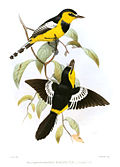| King of Saxony bird-of-paradise | |
|---|---|
 | |
| Male in Papua New Guinea | |
| Scientific classification | |
| Kingdom: | Animalia |
| Phylum: | Chordata |
| Class: | Aves |
| Order: | Passeriformes |
| Family: | Paradisaeidae |
| Genus: | Pteridophora A.B. Meyer, 1894 |
| Species: | P. alberti |
| Binomial name | |
| Pteridophora alberti Meyer, 1894 | |
| Subspecies | |
P. a. alberti | |
The King of Saxony bird-of-paradise (Pteridophora alberti) is a bird in the bird-of-paradise family (Paradisaeidae). It is the only member of the genus Pteridophora. It is endemic to montane forest in New Guinea.









